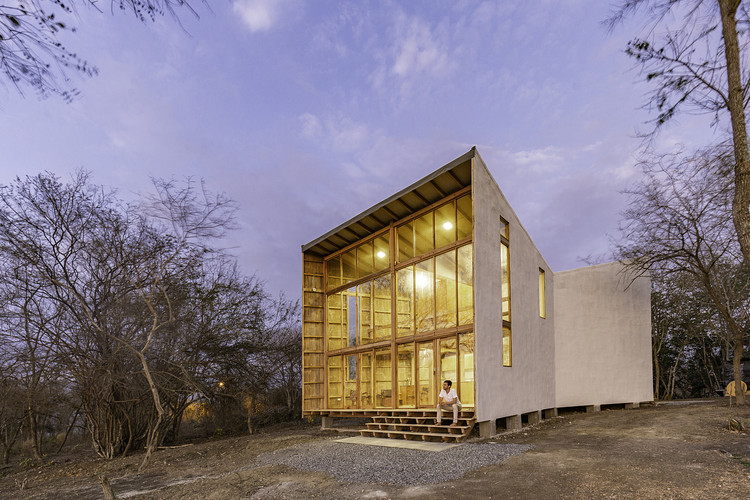Bråtejordet Skole White Arkitekter
2016-01-20 02:00
架构师提供的文本描述。在距挪威奥斯陆约20公里的老工业城镇Str mmen,White Arkitekter完成了一所新的中学Brtejordet Skole。这是新住宅区的第一个开发项目。学校在传统教育框架内提供创新的学习环境。怀特通过与挪威当地28家公司的设计竞赛赢得了该项目的冠军。获奖方案“Rammer og Niv er”(框架和级别)因其整体方法而受到高度赞扬。这项建议建立在明确的结构之上,其中空间界限是学校与社区之间以及学校不同部分之间的自然边界。这创造了一个平静和安全的教育学习环境-完全符合学校领导的愿望-使学生能够集中精力学习。从城镇到教室的过渡是通过四个不同的空间进行的:Tunet(院子)、Plat et(高原)、Boksen(盒子)和Rommet(房间)。
Text description provided by the architects. In an old industrial town, Strømmen, some 20 kilometres from Oslo in Norway, White arkitekter has completed a new secondary school, Bråtejordet Skole. It is the first development in a new residential area. The school provides an innovative learning environment within a traditional education framework. White won the project through a design competition competing against 28 local Norwegian practices. The winning scheme “Rammer og nivåer” (frames and levels).was highly commended for its holistic approach. The proposal is founded on clear structures, where spatial thresholds serve as natural boundaries, between school and community as well as between different parts of the school. This creates a calm and secure educational learning environment – entirely in line with the desires of the school leadership – which allows students to focus in their study. The transition from the town to the classroom takes place via four distinct spaces: Tunet (the yard ), Platået (the plateau), Boksen (the box) and Rommet (the room).
TUNET是转换区,你离开周围的社区,进入活跃的校园。它的两旁是树木,提供了一个明确的界限,并被划分为田野,暗示周围的农业景观,与社会地区包括野餐长椅和一个阶梯的座位舞台,在该地区的L形图的建筑。下一层,Plat et,是学校的入口大厅,它位于街道上方1米处的一个桥墩上。大的琉璃墙部分提供了周围景观的看法,广阔的高天花板是动画的屋顶灯光模式,淹没在房间的日光。设计车间、音乐工作室、图书馆和行政机构都围绕着这个中心房间,创造了一个充满活力的空间,用作门厅、食堂和会议厅。
Tunet is the changeover zone, where you leave the surrounding community and enter the active schoolyard. It is lined with trees providing a clear demarcation and is divided into fields that allude to the surrounding agricultural landscape, with a social area incorporating picnic benches and a stepped seating stage in the area sheltered by the L-shaped plan of the building. The next level, Platået, is the school’s entrance concourse, which is raised on a plinth 1m above the street. Large glazed wall sections provide views out across the surrounding landscape and the expansive high ceilings are animated with a pattern of roof lights which flood the room with daylight. Design workshops, music studios, a library and administration are organised around this central room, creating a dynamic space that functions as foyer, canteen and assembly hall.
较高层次的博克森(Boksen)被划分为每年一组的区域,包括专门的教师办公室和休息区,以及通往底层循环区的单独楼梯。在博克森,学习环境不如入口楼层开放,形成了一个更集中的学习环境。最后,罗梅特是教室。每个单元构成一个单元的连接,该单元包含一个相邻的突破空间、厕所和学生储物柜。教室布置在建筑物的边缘,面向东北和西北,以最大限度地利用太阳能和远离操场,以尽量减少分心。
The upper level, Boksen, is divided into zones for each year group, incorporating dedicated teachers' offices and break areas as well as separate staircases leading to the circulation areas on the ground floor. In Boksen, the views are framed and the learning environments are less open than on the entrance floor, creating a more focused environment for study. Finally, Rommet is the homeroom. Each one forms the nexus of a unit incorporating an adjacent breakout space, toilet and student lockers. Classrooms are arranged around the edges of the building, facing northeast and northwest to maximise solar gain and away from the playground to minimise distractions
这座建筑有一个L形的平面图,把南面的院子围起来.它的特点是它的屋顶曲折的形式,创造了一个强有力的锯齿轮廓参照斯特罗姆人的工业历史,同时也形成了非常宽敞的内部非常高的天花板。我们的客户,Skedsmo市,想要一所在功能、教育环境和长期可持续性方面具有100年生存能力的学校。由于空间规划、材料选择和能源战略的结合,预计每年的能源使用量为79千瓦时/平方米,相当于挪威能源A级。
The building has an L-shaped plan which encloses the south facing yard. It is characterised by the zigzagging form of its roof which creates a strong saw tooth silhouette referencing Strømmen’s industrial history, whilst also forming very spacious interiors with very high ceilings. Our client, Skedsmo municipality, wanted a school for the future with a 100-year viability in terms of functionality, educational environments and long-term sustainability. The combination of spatial planning, material choices and energy strategies has resulted in an predicted annual energy use of 79 kWh/m2, equivalent to Norwegian Energy Class A.
高质量的硬耐磨材料是指定的自始至终。承重隔墙由浇筑混凝土制成。膨胀的地板到天花板的玻璃结合一个轻的水磨石地板创造了一个明亮的内部,这与院子的苍白混凝土结合,创造了一个从外部无缝过渡。学校的折叠式屋顶上覆盖着青翠的景天,以减少雨水流失,并用天窗刺穿以获得自然光。黑色的外表由波纹的、预先涂好的铜组成,这是一种活生生的材料,它的老化非常美丽.每天早晨,紫铜里的晨光映照着学生和老师。
High quality hard-wearing materials are specified throughout. The load bearing partition walls are made of cast concrete. Expansive floor to ceiling glazing combined with a light terrazzo floor creates a light and bright interior, which merges with the pale concrete of the yard creating a seamless transition from outside in. The school’s folded roof is covered in verdant Sedum to reduce rainwater run-off, and punctured with skylights to bring in natural light. The dark exterior consists of corrugated, pre- patinated copper, a living material which ages beautifully. The reflections of morning light in the copper greet students and teachers each morning.
Architects White Arkitekter
Category Elementary & Middle School
Design Team Thomas Landenberg (head architect), Karin Jakobsson, Karin Sjödin (head of landscape), Jeroen Matthijssen, Lars Zackrisson, Christian Wahlström, Lena Osvalds, Mikaela Åström Forsgren, Daniel Hultman.
 举报
举报
别默默的看了,快登录帮我评论一下吧!:)
注册
登录
更多评论
相关文章
-

描边风设计中,最容易犯的8种问题分析
2018年走过了四分之一,LOGO设计趋势也清晰了LOGO设计
-

描边风设计中,最容易犯的8种问题分析
2018年走过了四分之一,LOGO设计趋势也清晰了LOGO设计
-

描边风设计中,最容易犯的8种问题分析
2018年走过了四分之一,LOGO设计趋势也清晰了LOGO设计

































































